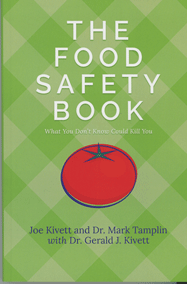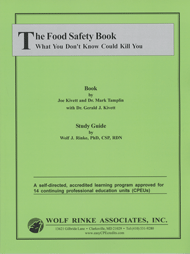|
The Food Safety Book: What You Don't Know Could Kill You
Book by Joe Kivett and Dr. Mark Tamplin with Dr. Gerald J. Kivett
Study Guide by Wolf J. Rinke, PhD, CSP, RDN
| C302 |
14 CPEUs |
HARD COPY |
$128.95
|
|
Course Expires: 5/31/2024
Book, 221 pgs, and Study Guide with 1 Reporting Form, 25 pgs.
The Centers for Disease Control and Prevention (CDC) estimates that 48 million Americans are affected by foodborne illness each year, 128,000 are hospitalized, and about 3,000 die. This CPE program answers just about every food safety, quality, and storage-related question and provides practical information including:
- An “A to Z” Guide to selecting and storing over 75 fruits and vegetables
- Storage and longevity charts for over 340 items including spices
- Helpful tips on how to keep food fresher longer
- Foods to avoid when pregnant and baby food do’s and don’ts
- A guide to preventing, identifying, and treating numerous foodborne illnesses
For more information and customer comments, click
here.
Approved/Accepted by CDR
For RDs/RDNs & DTRs/NDTRs for the Professional Development
Portfolio
SUGGESTED Learning Need Codes:
2000, 2030, 4000, 4040, 4130, 6000, 8000, 8018, 8040, 8060, 8070, 8130
SUGGESTED Performance Indicators (PIs):
7.1.2, 7.1.3, 7.2.1, 7.2.2, 7.2.4, 7.2.5, 7.2.7, 7.2.8, 7.2.9, 7.2.10, 7.2.11, 8.1.4, 8.3.1, 8.3.6, 8.4.1, 8.4.3, 12.1.3, 13.1.2, 13.1.6, 13.1.7, 13.2.5
DON'T SEE your Performance Indicators or Code Listed here?
There are many Performance Indicators (PIs) that are applicable we can't list them all & Per CDR you may use ANY PI or CODE as long as it relates to your Learning Plan.
For details click here.
Share with a friend and Save! Click here for important information about
sharing.
To order an ADDITIONAL Reporting Form click below:
| C302F |
14 CPEUs |
REPORTING FORM |
$40.00 |

|
The Food Safety Book: What You Don't Know Could Kill You
Book by Joe Kivett and Dr. Mark Tamplin with Dr. Gerald J. Kivett
Study Guide by Wolf J. Rinke, PhD, CSP, RDN
©2017 Wolf Rinke Associates. No part of this
publication may be reproduced, stored in a retrieval system, or transmitted
in any form or by any means, electronic, mechanical, photocopying,
recording, scanning, or otherwise, without the prior written permission
of the Publisher.
CUSTOMER COMMENTS
Mary Kohring - "I liked the tables that highlighted the foods and storage guidelines."
Cynthia Trapano - "A lot of great reference charts in the book and good, practical food service information."
Deborah N. Mannion - "Altered my understanding of food storage of select vegetables. Learned more about holding temps for cooked foods. Updated my knowledge regarding food-borne illnesses in the 10 years since I took HACCP. I felt the information was detailed but also concise and interesting."
Shannon G. Kennedy - "I love the layout of the book as well as the easy to reference Guides. I don't utilize this information frequently so having an easy to find and reference layout for food-borne illness was nice. I also liked the Food Storage and Longevity Charts."
OVERVIEW AND INSTRUCTIONS
Welcome to the pre-approved, accredited CPE program for The Food Safety Book. The program consists of a book of the same title by Joe Kivett and Dr. Mark Tamplin and this study guide. This CPE program is designed to help you answer food safety questions from your clients and customers and to ensure that your facility serves safe foods. It is also designed to help you earn 14 Level 2, Continuing Professional Education Units (CPEUs).
To get the most out of this CPE program, it is suggested that you adhere to the following four steps:
- Review the objectives in this study guide.
- Read and study the book.
- Assess what you have learned by answering the self-assessment questions in this study guide.
- Compare your answers to the answer key, which you will find at the end of the study guide. If you scored at least 80% (40 questions) correct, you have completed the program and are ready to transfer your answers to the CONTINUING PROFESSIONAL EDUCATION REPORTING FORM in front of this study guide. If you scored less than 80% correct, re-read the appropriate sections of the book and until you score at least 80% (40 questions) correct.
After you have successfully completed the program, complete the CPE REPORTING FORM and:
Submit on-line at www.easyCPEcredits.com,
Or fax to: (410) 531-9282,
Or mail to: Wolf Rinke Associates, 721 Valley Forge Road #486, Valley Forge, PA 19481
We will email your Certificate of Completion.
When you submit your CPE Reporting Form to us via www.easyCPEcredits.com, fax, or mail, be sure to write your correct email address in the space provided on the CPE Reporting Form. If writing by hand, be sure to print your email address clearly.
To ensure that our emails are delivered to your inbox (instead of your junk/spam folders), please add cpesupport@wolfrinke.com to your Address Book or Safe List of allowed email senders. Also, be sure to allow attachments from this email address.
LEARNING OBJECTIVES
Upon completion of this CPE program you will be better able to:
- Apply the four basic concepts of food safety.
- Implement the single most important strategy to avoiding foodborne illnesses.
- Apply principles of safe food handling from purchase through storage, preparation and service.
- Explain how to select and safely store all foods in your facility.
- Explain product dating and grading.
- Keep food fresher longer.
- Reduce food waste.
- Distinguish between foodborne illness, food poising and gastroenteritis.
- Recognize the characteristics of potentially hazardous foods.
- Apply specific techniques to prevent the spread of disease.
- Identify foods to avoid when pregnant.
- Explain baby food do’s and don’ts.
- Maintain food safety when serving food outdoors and traveling abroad.
- Create and maintain a clean and sanitized foodservice environment.
- Recognize the major causes of foodborne illnesses, organisms involved, symptoms, duration, and prevention.
- Identify and prevent numerous foodborne illnesses in your facility.
TABLE OF CONTENTS
Introduction
The Four Basic Concepts of Food Safety
PART I: PURCHASING YOUR FOOD
Safely Selecting and Transporting Food Products
Understanding Product Dating
Filling the Shopping Cart
Bagging It
Loading the Car and the Ride Home
PART II: AN "A TO Z" GUIDE TO FRESH FRUITS AND VEGETABLES
Fruits
Vegetables
PART III: STORING YOUR FOOD
Storing Food Products
Perishable Foods
Storage Location for Fruits and Vegetables
Nonperishable Foods
Refrigerator Safety
Freezing When It's Fresh
Packing Food for the Freezer
PART IV: FOOD STORAGE AND LONGEVITY CHARTS
Bakery Items
Foods Purchased Frozen
Foods Purchased Refrigerated
Fresh Foods
Shelf Foods
Shelf-Stable Foods
PART V: IN THE KITCHEN
Creating a Clean and Sanitized Environment
Clean and Sanitized Hands
Countertops and Sinks
Homemade Sanitizing/Disinfecting Solutions
Cutting Board Safety
Towel and Sponge Safety
PART VI: PREPARING YOUR FOOD
Thawing Food Safely
Washing Fruits and Vegetables
Marinating Food
PART VII: SAFE COOKING PRACTICES
Thermometers
Cooking Eggs
Homemade Flavored Oils and Vinegars
Cooking Meats and Poultry
Cooking Seafood
Preparing Wild Game
Cooking Stuffed Foods
Cooking in the Oven
Cooking in the Microwave Oven
Cleaning Up After Cooking
Managing Leftovers
Takeout Food
Bag Lunches
PART VIII: HOLIDAY FOOD SAFETY
Ham
Turkey
Roasts
Serving at Holiday Parties
Storing and Reheating Leftovers
Eggs and Easter
Mail Order Foods
Sending/Shipping Perishable Food From Home
How to Host a Safe Party
PART IX: THE GREAT OUTDOORS AND TRAVELING ABROAD
Camping, Picnics, and Traveling
Food Storage
Clean Hands and Utensils
Rugged Camping
Guidelines When Traveling Abroad
PART X: FOODBORNE ILLNESS
Understanding Foodborne Illness
What is Foodborne Illness?
Primary Cause
Treatment
Common Types of Foodborne Illness
Helpful Tips
Afterword
Index
References
Additional Resources
About the Authors
ABOUT THE AUTHOR OF THE STUDY GUIDE
Wolf J. Rinke, PhD, RDN, CSP is the president and founder of Wolf Rinke Associates, a company that has provided high quality CPE programs to nutrition professionals since 1990.
He earned a BS at Drexel University, a MS at Iowa State University, a PhD in Continuing and Vocational Education (Adult Ed) at the University of Wisconsin, and interned at Walter Reed Army Medical Center. He participated in a test item writer workshop sponsored by the Commission on Dietetic Registration (CDR).
Wolf is a past Adjunct Associate Professor, Graduate School of Management & Technology, University of Maryland, and a former Adjunct Faculty Member, School of Continuing Studies, The Johns Hopkins University.
He is the past president of the DC Dietetic Association and has been honored by the Academy with the Award for Excellence in the practice of Management; the Outstanding Dietitian of the Year Award; the Outstanding Service Award; and has delivered the Lenna Frances Cooper Lecture.
At the Academy he has served in numerous leadership roles including Chair, Scholarship Committee, DBC; Chair, Communication Committee, CDR; Chair, Area Coordinating Committee, COE; Chair, COE, and member of Resource for Education Programs Committee; Honors Committee; CDR, Licensure Panel and Ethical Practices Task Force; CDR; House of Delegates and Board of Directors.
He is the author of more than 500 articles, numerous CPE home-study programs, several popular books, and the free monthly eNewsletter Read and Grow Rich written specifically for savvy Nutrition Professionals like YOU!
Subscribe now at www.easyCPEcredits.com--you’ll be glad you did!
ACKNOWLEDGEMENTS
Special thanks to the following individuals for their careful review of this CPE program.
Donna S. Martin, EdS, RDN, LD, SNS, FAND
Director, School Nutrition Program
Burke County Board of Education
Waynesboro, GA
Richard Patterson, EdD, RDN
Associate Professor
Western Kentucky University
Bowling Green, KY
Robin Meicke-Taylor, MS, RDN
Business Account Manager
Nestle Health Science
Secaucus, NJ
If you prefer to order by phone, mail
or fax click below
or click here to contact us with
other questions.
For information about our other products and
services return to the sidebar at the top of the page.
|
custom |
|



